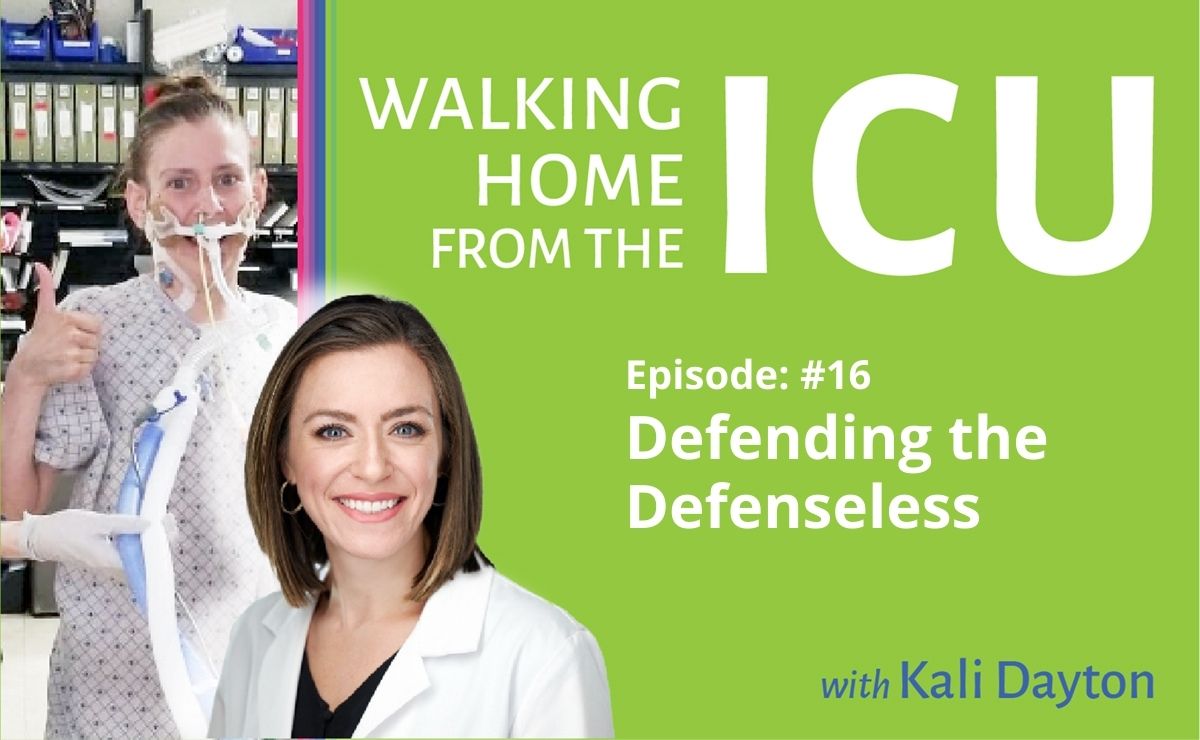SUBSCRIBE TO THE PODCAST
In this episode, we look at how James was admitted for severe mycoplasma pneumonia that turned into mild ARDS and how his Downs Syndrome and autism inspired the ICU team to get creative to keep him awake and walking on the ventilator.
Episode Transcription
Kali Dayton
I want to tell the story for someone that cannot tell themselves.
A few months ago, we were blessed to admit a wonderful young man with Down syndrome, autism and a cognitive function level of a two to three year old. We will call him James. James came into the ICU for severe mycoplasma pneumonia. And as soon as he rolled in, he was intubated, requiring Fi02 to 80% and peep of 16 on the ventilator.
The moment after intubation was pivotal, as things still are in our critical care world. I suspect that normally, there either would have not been a discussion, and he would have automatically been deeply sedated. Or this discussion would have been, “This kid is going to be impossible to manage with his cognitive disabilities. We better sedate him.” Yet, this team had a different perspective. His safety and tolerance of the ET tube was of the utmost importance. Yet they were able to stand at the watchtower and see the big picture- the end from the beginning.
They knew that if he was sedated, he would not be walking. With Down Syndrome and a baseline low muscle tone. What would happen to him if he became weaker? Would he be able to be extubated? Would that destined him to a tracheostomy and long term acute care hospital ( LTACH ) admission? Would he be able to regain that strength and be physically independent again?
They knew that if they were to sedate him, he would be much more at risk of developing ICU delirium with his autism and sensory sensitivities. What would it be like for him to have some hallucinations and scary delusions? What kind of trauma and PTSD would that cost him? They understood that sedation and ICU delirium would sign him up for cognitive deficits down the road. With a baseline capacity of two to three years old, would that take away his ability to play with his favorite toys? feed himself? Play with his brother and his dog?
Surely it would be easier for the staff to have him comatose. But would it be worth it? Could we rationalize the damage that would cause him? They asked the questions that Dr. Ely poses: What can we do FOR him, not TO him.
Fortunately, this team saw him as more than a pair of sick lungs. They had lots of experience and tricks up their sleeves. They did put him on dexmedatomodine for the night. And in the morning, it was off and never went back on. They moved him to a room that had a couch for the parents to sleep on. The parents took shifts during the day and the night and were the familiar faces for him. They had a sitter at night to hold his hand. The staff built a tent over his bed like the one he sleeps in at home. He was restrained, but still able to play with his toys and iPad.
As long as he had his favorite cartoons, music, iPad, toys, parents and a handhold. He was happy. He did not express any anxiety or fear. He was allowed to continue to be himself and the team embraced and even celebrated his individuality. Even at home, he loved to cross his legs. In bed in the hospital, he would sit with his legs crossed. Rocking was a way for him to soothe himself and express joy. He would sit in bed and rock.
When he was walking on the ventilator, he would stop, sit down, and cross his legs like he always does. Everyone understood that that was his style. So they would let him they would just stop and wait until he was ready to pop back up and keep walking. It was his thing.
He continued to walk three times a day. After 11 days on the ventilator, he was successfully extubated. After a few days. He walked out of the hospital and went straight home with his family. He did go home with a feeding tube for likely baseline aspiration. He continued to work with speech therapy outpatient and was able to week eat again a week after.
It was in that pivotal moment after intubation, and throughout his stay, that this team determined James’ quality of life.
Was more work to have him awake? – Probably.
Would it have been easier to have him motionless?- Of course.
Would his outcomes have been different, with different treatment? –
Without a crystal ball, or any wish to go back and try it a different way. I firmly believe that James’s outcomes were changed by how he was managed.
I strongly suspect that if he had been sedated and immobile, he would have become a classic “trach and PEG patient” and sent to LTACH.
So, was it worth it? — Everyone on the team deeply felt that it was worth it.
This is why we signed up for this. We want our patients to succeed. We want to advocate for and defend the defenseless. This team saw James as a whole. They saw what value mobility and function had in his life and his family. They knew their why, and they find found the how for James and his family.
Transcribed by https://otter.ai
SUBSCRIBE TO THE PODCAST




